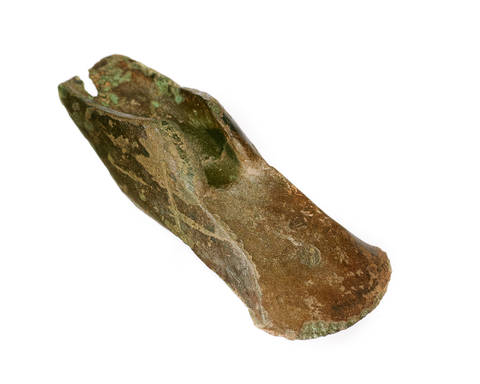Collection
—
This timeline features objects, documents and photographs from our Archives and Museums Collections. We have selected 10 items per town or village to create an eclectic time line of East Dunbartonshire in 110 objects. There is no intention to suggest a hierarchy of significance either by inclusion or exclusion. We value all our collections equally.
330,000,000 BC
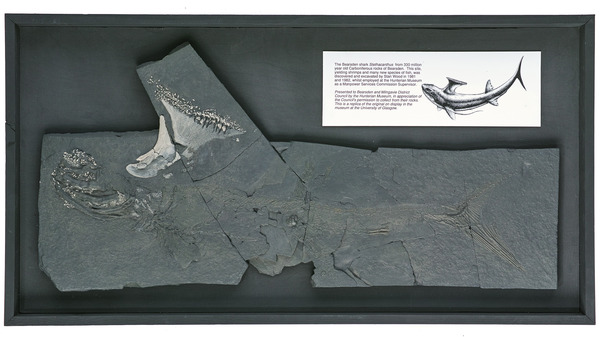
The Bearsden Shark
—
330,000,000 BC
This is a plaster cast – the original fossil is housed in the Hunterian Museum, Glasgow University. The conditions in the shallow tropical seas of the Carboniferous period left Scotland with a wealth of well-preserved shark fossils. The fossil, ‘Akmonistion zangerli’ (affectionately known as ‘The Bearsden Shark’), is a complete skeleton of a 330 million year old shark, a species previously unknown to science. It was discovered by Stan Wood in the shale beds of the Manse Burn in Bearsden in 1981. The detail of the fossil reveals blood vessels and remnants of muscles, even the remains of the shark’s last meal can be seen inside its stomach. Edwin Morgan wrote a poem celebrating its discovery.
Location of Origin: Bearsden
Location Now: Lillie Art Gallery
Date: 330,000,000 BC
Size/Dimensions: 42.5cm X 78.5cm (Framed)
Locations:
3500 BC

Neolithic Carved Stone Ball
—
3200 – 2500 BC
This Neolithic carved stone ball is the oldest artefact or man-made object in the Auld Kirk Museum’s collection. It has six equally proportioned and positioned knobs. It was found in a garden in Lenzie in the 1970s. Carved stone balls may be up to 5,000 years old. This example is made from rock that is common in the South West Highlands of Argyll and joins a small number of these stones found outside the north-east of Scotland. It became part of the Auld Kirk Museum’s collection in 2011 as a result of Scotland’s Treasure Trove system.
Carved stone balls come in various shapes and sizes and are of interest to mathematicians because of their geometrical sophistication. Maybe they were used as a kind of currency or a counting and numbering system? They suggest that Neolithic society was not as simple or primitive as previously assumed. The meaning and purpose of this object remains a mystery, and we will probably never know what it was used for. The most we can say is that it is a prized object now and it was probably a prized object 5000 years ago.
(Purchased with assistance from the National Fund for Acquisitions)
Maker/Manufacturer: Antiquity
Location of Origin: Found in Lenzie
Location Now: On display in Auld Kirk Museum, Kirkintilloch
Date: 3200 – 2500 BC
Size/Dimensions: 70mm diameter approx
Materials: Stone - Green/grey appearance. Area of rock origin – probably South West Highlands – Callander area/Argyll. Might be part of a rock unit called the ‘green beds’ of the South West Highlands. Green flaked appearance. Minerals: chlorite and epid
Accession Number: KITAK: 2011.4
Locations:
1500 BC
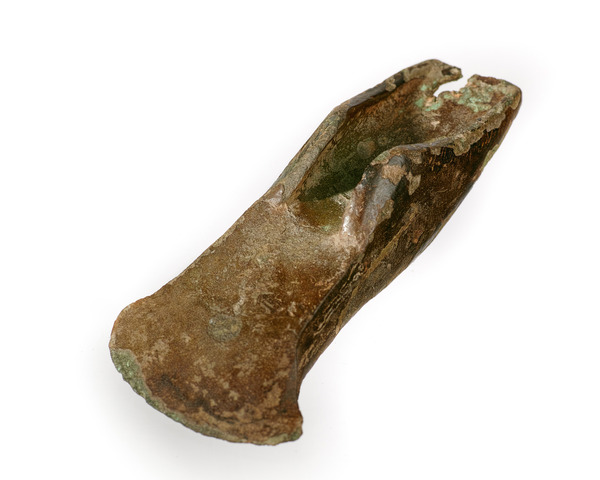
Bronze Age Axe Head
—
1400 – 1300 BC
This axehead was acquired as a result of the Treasure Trove system. The role of Treasure Trove is to ensure that objects of cultural significance from Scotland’s past are protected for the benefit of the nation and preserved in museums across the country. This is a reasonably well-preserved example of a Middle Bronze Age flanged axehead, belonging to a grouping classified as Baldersby axes, named after a North Yorkshire find. Baldersby axes are considered to date from around 1400-1300 BC. Bronze is made by melting copper and tin and mixing them in a crucible in a furnace. The molten metal was then cast into shape using stone or stone and clay moulds. People looked upon metalworking as a kind of magic, bringing something new into existence: melting rocks to forge metal. This axehead takes us back to the time when metal working technology was spreading across Britain and Europe. This particular example may have originated in Ireland and perhaps this was used for working wood? We’ll never know for sure.
Location of Origin: Bardowie
Location Now: Auld Kirk Museum
Date: 1400 – 1300 BC
Size/Dimensions: 10cm x 44cm (Weight – 204 gms)
Materials: Bronze
Accession Number: KITAK: 2012.16
Locations:
100
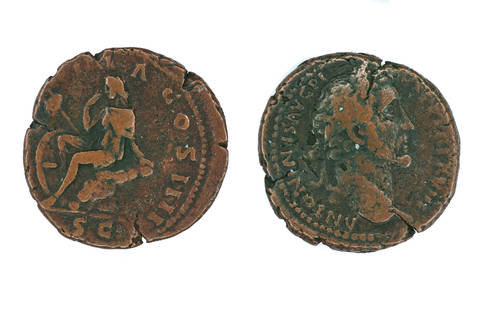
Copper Coin of Antoninus Pius
—
138 – 165
Following Hadrian’s death in 138 A.D., his successor, Antoninus Pius, went beyond the recently completed Hadrian’s Wall and ordered the construction of a new frontier 75 miles to the north, the Antonine Wall. The Antonine Wall divided communities, created customs posts and checkpoints, and provided opportunities for corruption and abuse. The Antonine Wall was inhabited for only 20 years before a return to Hadrian’s Wall as the northernmost outpost of the Roman Empire. Unlike Hadrian, Antoninus Pius never visited Britain. The majority of artefacts and records from the time that Britain was occupied come from the Romans. The colonised left no written records. The Antonine Wall ran close to present day Twechar, with the ruins of the large Bar Hill fort still visible to the south of the village. There is little known about the development of the area after the Roman occupation. In the early 18th century rudimentary mines were developed, however, the beginning of modern Twechar is linked to the arrival of the Forth and Clyde Canal in 1768 and by the early 1860s it had developed further with William Baird and Company bringing full-scale coal mining to the area.
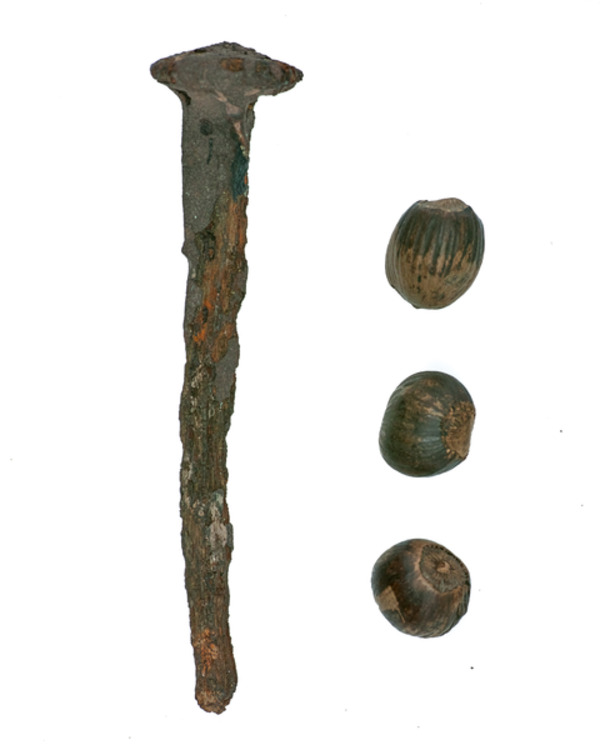
Nail and three hazel nuts from the Bearsden Roman Dig
—
c 150
The Antonine Wall in East Dunbartonshire has been excavated on numerous occasions. The Glasgow Archaeological Society undertook the earliest scientific investigation of the visible remains in 1890 – 93.
Excavations and archaeological work, in the vicinity of Peel Park, for example, was carried out in 1899, 1906, 1914, 1952 - 1961, 1975, 1978 - 1979, 1988, 1989, 1992, 1995, 2002 and 2006.
A series of excavations began in Bearsden in 1973 and by 1982 a fairly comprehensive plan of the fort was possible. The stonework of the bathhouse discovered in 1973, constitutes the most impressive single building to be seen along the Antonine Wall.
Analysis of sewage deposits to the east of the bathhouse indicated that the soldiers’ diet included raspberries and figs. Coriander and poppy seeds, also found, were probably used in flavouring wholemeal bread. Hunting was a popular off-duty activity among Roman soldiers. The presence of animal bones indicates that some meat was consumed, although it is thought that the diet was primarily vegetarian with amounts of cereal products.
From the late 18th century onwards, objects from the Antonine Wall began to be discovered as a result of industrial development including the construction of roads, the Forth and Clyde canal, the growth of towns and villages and the intensification of farming. Many of the objects went to the Hunterian Museum at the University of Glasgow which was the only public museum in existence at that time in Scotland.
Maker/Manufacturer: The Romans
Location of Origin: Roman Road, Bearsden
Location Now: Auld Kirk Museum
Date: c 150
Materials: Iron
Locations:

Parchment and seal
—
1518
This manuscript is written in old Scots and describes the transfer of a piece of land to the east of the Luggie Water in Kirkintilloch. The land is being passed to John Dollar by William Jack and his wife Janet. The wax seal was originally attached to the manuscript but has become detached sometime over the centuries. Recent cleaning of the seal by conservators has revealed the Latin inscription ‘SIGILLUM COMMUNITATIS DE KYRKINTOLAT’ which translates as the ‘seal of the community of Kirkintilloch’. There is a fortified tower depicted on the seal which could well be Kirkintilloch Castle. From this evidence it is likely that this is the earliest known example of the official Kirkintilloch Burgh Seal.
Location of Origin: Kirkintilloch
Location Now: East Dunbartonshire Archives, William Patrick Library, Kirkintilloch G66 1AD
Date: 1518
Size/Dimensions: manuscript 240 mm x 110 mm, seal 65 x 70 mm
Materials: The manuscript is on parchment (parchment was made from dried animal skin -usually from a calf, sheep or goat) and the seal is made from wax
Archive Reference Number: GD353
Locations:
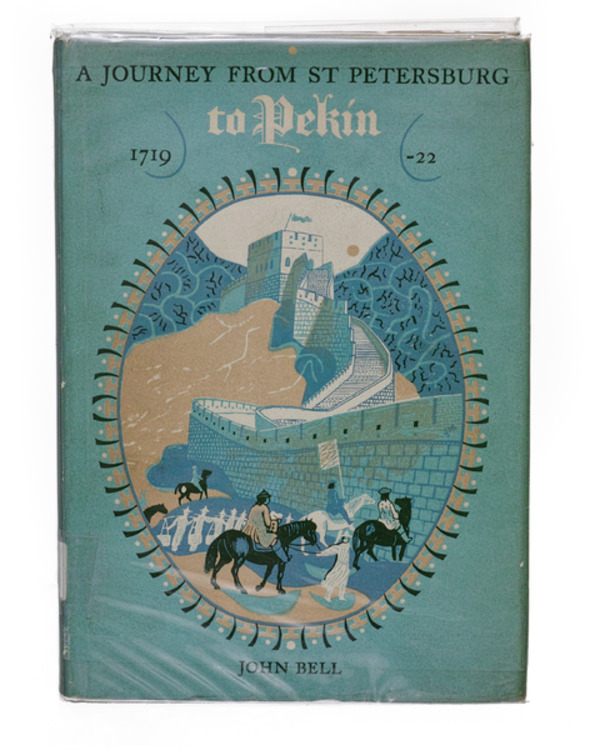
John Bell of Antermony
—
1763
John Bell of Antermony (1691-1780) was a Scottish physician and traveller. He wrote an account of his adventures called 'Travels from St Petersburg in Russia to Various Parts of Asia' which was published in 1763. This image shows the cover art for 'A journey from St Petersburg to Pekin, 1719-22', by John Bell of Antermony; edited with an introduction by J. L. Stevenson and published in 1965. This is reprinted from 'Travels from St. Petersburg in Russia, to diverse parts of Asia' originally published by R & A Foulis, Glasgow, 1763.
Location of Origin: Antermony, Milton of Campsie
Date: 1763
Size/Dimensions: xi, 248 p. front., illus., 28 plates (incl. ports., col. map) tables, facsim. 26 cm
Archive Reference Number: LC 915
Locations:
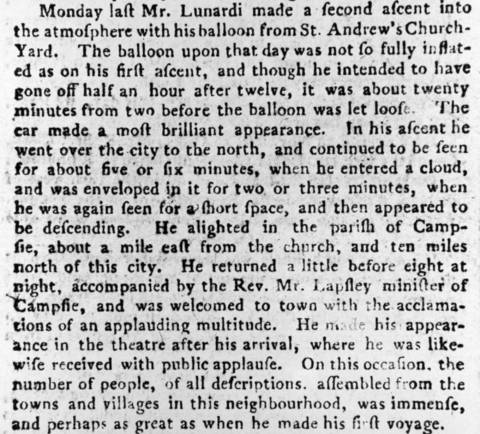
Newspaper report of Lunardi's balloon flight
—
1785
Vincent Lunardi was a pioneering Italian aeronaut. On 5 December 1785 he took off in his balloon from St Andrews Square, Glasgow. However the poor weather caused him to come down in Milton of Campsie - much to the surprise of the local people. The Campsie parish minister, the Rev Lapslie accompanied him back to town. His landing is marked by a small plaque in the village.
Location of Origin: Milton of Campsie
Location Now: East Dunbartonshire Local Studies
Date: 1785
Size/Dimensions: 10 x 8 in
Materials: Photographic print (copy of original)
Archive Reference Number: P13986
Locations:
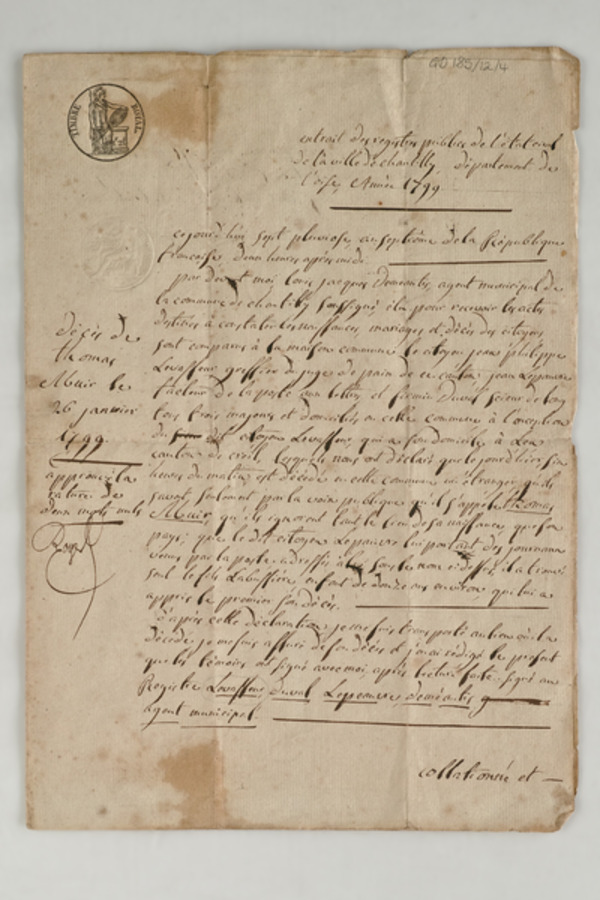
Thomas Muir death extract
—
1799
This is an extract from the civil register of Chantilly, France, recording the death of Thomas Muir, and is dated 26 Jan 1799. Thomas Muir (b 1765-d 1799) of Huntershill near Bishopbriggs, was a Scottish political reformer. He was one of the 'Scottish Martyrs', five men who were 18th century political reformers. In 1793 they were sentenced to transportation to Australia for sedition and writing and publishing pamphlets on parliamentary reform. Muir escaped and after a very eventful voyage made it to Paris, France. Unfortunately his experiences had caused his health to suffer and he died there in 1799. Thomas Muir is now known as 'The Father of Democracy' following a resurgence of interest in his story in recent years. This document, written in French, was found in the papers of Peter Mackenzie, (b 1799-d 1875) editor of the Glasgow Gazette, himself a staunch supporter of political reform.
Location of Origin: Chantilly, France
Location Now: East Dunbartonshire Archives, William Patrick Library, Kirkintilloch G66 1AD
Date: 1799
Size/Dimensions: 21 x 29.5 cm
Materials: Paper
Archive Reference Number: GD185/12/4
Locations:

John Henderson volumes
—
1821-1830
This mystery donation was sent to Bishopbriggs Library in November 2013, and has since been added to the Archive collections. It arrived in the mail one morning, sent by second class post in an ordinary brown envelope. Luckily what was inside survived it's journey through the post, as the envelope revealed two volumes dating from the early 1800s. The first volume, dating from 1821-1825, appears to be a record of joinery work carried out at various places in 'Bishops Bridge' including Huntershill House, Cadder and Kenmure as well as surrounding areas such as Campsie Kirk. The work ranges from producing gates and doors to coffins and beehives. There is a record of individual men's work, together with a date, description of the work and the number of days taken to complete the job. There is also a second smaller volume with 'Mr John Henderson Bishop Bridge in account with James Martin & Sons' written on the front cover. This volume lists supplies purchased such as nails, screws, saws and hinges, and dates from 1827-1830. If you are the mystery donor, or if you have any more information on John Henderson of Bishops Bridge, please do get in touch.
Maker/Manufacturer: John Henderson, builder and wright, Bishopbriggs
Location of Origin: Bishopbriggs
Location Now: East Dunbartonshire Archives, William Patrick Library, Kirkintilloch G66 1AD
Date: 1821-1830
Materials: 20 x 24.5 cm, and 10 x 15.5 cm
Archive Reference Number: Acc2013/19
Links:
Locations:
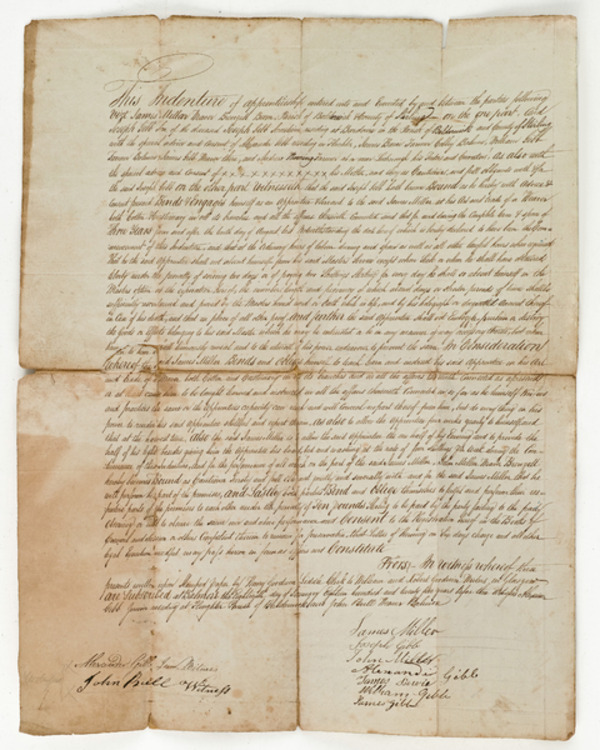
Apprenticeship indenture
—
1824/5
This is an official document recording the apprenticeship of Joseph Gibb of Bardowie in Baldernock Parish to James Millar, a weaver in "Brenzet Burn" or Branziet Burn, Baldernock. Joseph Gibb has signed on to a 3 year apprenticeship with James Millar to learn the "art of weaving" from him.
Location of Origin: Baldernock
Location Now: East Dunbartonshire Archives, William Patrick Library, Kirkintilloch G66 1AD
Date: 1824/5
Size/Dimensions: 32 x 42 cm
Materials: Paper
Accession Number: Acc 2014/25
Links:
Locations:

Waggon train
—
1828
This print shows a Clydesdale horse called Dragon pulling a train of waggons loaded with 50 tons of coal along the newly opened Monkland & Kirkintilloch Railway. The Monkland and Kirkintilloch Railway opened in 1826, and was built to carry coal from collieries in Monklands to the Forth & Clyde Canal at Kirkintilloch for onward shipment. It was only the second public railway in Scotland, and the first with rails strong enough to support steam locomotives.
Maker/Manufacturer: T Paterson, Trongate, Glasgow
Location of Origin: Kirkintilloch
Location Now: East Dunbartonshire Archives, William Patrick Library, Kirkintilloch G66 1AD
Date: 1828
Size/Dimensions: 41 x 26 cm
Archive Reference Number: T25/20/147
Links:
Locations:

Weavers Banner
—
1832
Believed to have been carried during marches supporting the 1832 reform bill.
On it can be seen the scales of justice and a Phrygian cap – a French revolutionary symbol of liberty, and the following words:
1832 - NOTHING SHALL EXTINGUISH LIBERTY –
REFORM REDRESS RELIEF
THE VOICE OF THE PEOPLE IS THE SUPREME….
A section on the right of the banner is missing.
Found in former weaver’s cottage in Waterside.
Influenced by the French Revolution and political activists and radicals such as Thomas Muir, many weavers, along with other working people in impoverished circumstances, looked for a political solution to their plight.
They tried to form combinations or unions to protect their wages and conditions, but these generally failed because wages were so low that the unions could not support long strikes. Riots occurred throughout the west of Scotland. Large meetings were held in Glasgow and the surrounding area, and secret reform societies were set up in many towns including Kirkintilloch. Weavers played an important part in this radical activity. The 1832 Reform Bill promised a start towards improved conditions for workers and gave political representation to a larger section of the population.
“In June 1832, for example, the Scottish websters were warned that although there were signs of impending cyclical recovery in the economy, they could expect ‘little or no solid benefit’ until the Corn Laws were abolished (1). And it seems that certain elements of the weaving population took that warning seriously: for in August 1832 a meeting of Kirkintilloch weavers passed a resolution to request all those in the district now possessed of the franchise, to support only Parliamentary candidates who were in favour of free trade, and above all the destruction of the corn monopoly(2).â€
(1) Loyal Reformers’ Gazette , 23rd June, 1832.
(2) Scottish Guardian , 17th August, 1832.
In The Scottish Handloom Weavers 1790 – 1850 , Murray, Norman. Edinburgh, 1978.
Date: 1832
Size/Dimensions: 270 cm x 163.5 cm
Materials: Painted Linen
Accession Number: KITAK: 2008.4
Locations:

Lennox Castle specifications
—
1837
This volume contains specifications, estimates, contracts and accounts for the building of Lennox Castle. The large 3 storey red sandstone mansion was designed by prominent Glasgow architect, David Hamilton, in a Norman castle style for the Kincaid-Lennox family of Woodhead. The house took around 4 years to build and was finished in 1841. During the First World War, like many grand houses, Lennox Castle served as an auxiliary hospital for wounded soldiers. In 1927 the family sold the castle and the estate to Glasgow City Council. In 1936 the Council opened a new mental hospital on the estate. During the Second World War the hospital was again used as a military hospital with the patients being transferred to huts in the grounds. From 1942-1964 a maternity hospital operated at the complex. By 1987 the original castle building was no longer needed by the hospital. During the 1990s a phased closure of the hospital was carried out with Lennox Castle Hospital finally closing in 2002. Unfortunately the building was badly damaged by fire in 2008 and is currently on the Buildings At Risk Register.
Location of Origin: Lennoxtown
Location Now: East Dunbartonshire Archives, William Patrick Library, Kirkintilloch G66 1AD
Date: 1837
Size/Dimensions: 23 x 34 cm
Archive Reference Number: GD174/2
Locations:

Kirkintilloch Gas Light Company agreement
—
1838
Kirkintilloch Gas Light Company, certificate of co-partnership. This document is the longest item in East Dunbartonshire Archives, measuring an incredible 11.5 metres.. The Kirkintilloch Gas Light Company was formed in 1838 following delays in forming a municipal gas works by the town Commissioners. They erected their premises at Canal Street, and charged the town 3d per £ rental for supplies of gas to the lamp-lights. The town had to supply 50 of its own lamps, as well as a lamplighter, James Goodwin, the Superintendent of Police. The Burghs Gas Supply (Scotland) Act of 1876 allowed the Town Council to take over the company, and they took out a £15,000 loan in order to do so in 1876. It was reported in 1895 that the takeover had proved so successful that no increase in rates had been required to cover repayment of the loan. A new type of gas-meter, the 'penny in the slot' (which produced a certain amount of gas upon insertion of a coin) was introduced in 1898, and the town council tried to persuade people to convert to this new meter, fixing gas at the price of 2/8d per 1000ft2, with a reduction for those who used the new meters. Due to an increase in demand, further expansion was required, necessitating the construction of new premises in 1908, at a cost of £30,000. The local administration came to an end following the Gas Act of 1948, when gas supply was nationalised, and British Gas took over.
Maker/Manufacturer: Kirkintilloch Gas Light Company
Location of Origin: Kirkintilloch
Location Now: East Dunbartonshire Archives, William Patrick Library, Kirkintilloch G66 1AD
Date: 1838
Size/Dimensions: 11.5 metres
Archive Reference Number: BK/12
Links:
Locations:
...
